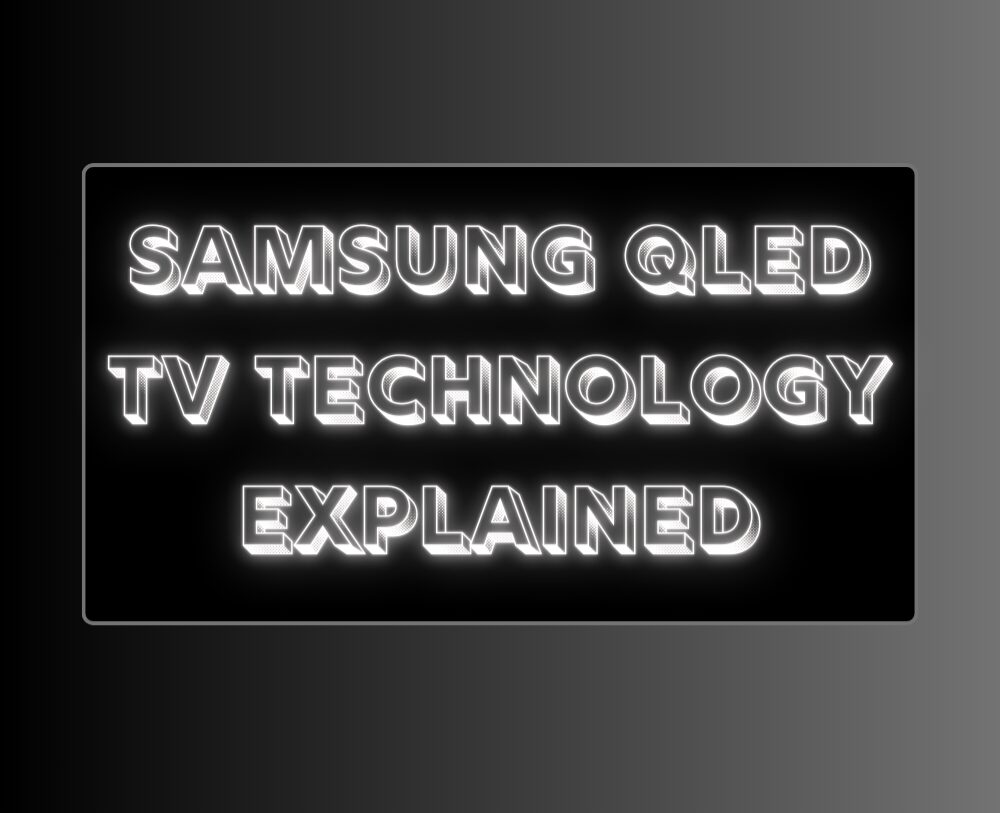What Exactly Is Samsung QLED Technology?
Samsung QLED TV Technology Explained

Here’s an interesting topic that I felt would be worth talking about today; QLED.
Whether it be introducing the world’s first bezel-less curved TV, or winning over 100 awards in a awards single show, Samsung aren’t strangers to breaking the mold.
So what is their QLED technology?
Let’s find out.
What’s The Name Mean?
QLED is actually an acronym, and stands for quantum dot light emitting diode.
The quantum dot part of it stems from Samsung’s own quantum dot technology from a few years back (meaning that it’s technically the next iteration of this)
So though this is still technically an LED TV; it’s their improved version.
But What’s A Quantum Dot?

I know by now you’re probably wondering what a quantum dot even is, so to put it simply, think of these as extremely tiny particles each capable of producing light.
Their small size is what also allows them to have greater color accuracy.
You see, in many televisions today, there are white LEDs that while bright, have trouble producing adequate saturated colors.
Quantum dots on the other hand utilize the blue LEDs from the backlight by transmuting the light those LEDs emit into either red, green, or blue, depending on the size of the dot.
This variation in size and precision at essentially the microscopic level is what allows quantum dot displays to be more colorful, brighter, and more accurate.
https://en.wikipedia.org/wiki/Quantum_dot_display
QLED Has Actually Been Around Since 2014
Technically it’s been around since about 2014, but was originally scrapped a little while later in lieu of working on other display technologies.
However in 2017, they resumed working on it again because they felt the current generation of TVs still had limitations.
That year, Samsung released the 3rd version of its signature series that brought with it some pretty important changes.
To appreciate those changes though, we would first need to understand how it works.
How Does QLED Work?
Remember that little tidbit earlier about quantum dots with how they change color depending on their respective size?
That’s exactly how.
They’re placed so closely together that they create a film that would then go in front of the backlight panel.
This film is what dictates how things look depending on how many of those dots are actually active.
Also each dot has a thinner aluminum inner & outer that lets more light pass through it.
This increase is what allows the screen to be brighter, as well as more colorful (very much so in person)
In fact, it’s able to display so many colors that it covers 100 percent of the DCI/P3 color spectrum; that’s over a billion for the unaware.
In other words, it’s able to display every color that the human eye can possibly see, becoming the first display technology capable of doing so.
Quite impressive to say the least.
What Are The Advantages?
A Higher Color Saturation
The first visual benefit QLED allows for is a higher saturation.
This is due to the fact it can cover the entire color spectrum which can make for images that are dramatically more vivid and intense.
Having a QLED TV myself, the colors and just how deep they looked was definitely one of the first thing I personally noticed.
Better Color Accuracy
The next advantage ties in with the previously mentioned one, in the form of its color accuracy.
By using quantum dots, the enhanced color accuracy allows for a more realistic image, and the benefit of that is pretty obvious.
You get scenes that can look closer to how they’d look in person, which further adds to the immersion.
A Brighter Image While Retaining Color Accuracy
Samsung’s QLED tech allows these TVs to get much brighter than they could previously, reaching a peak brightness of up to 1500 nits.
Think of nits as units of luminance; meaning the higher the number, the brighter the image.
For HDR, another prominent display technology, at least 1000 nits is recommended for an impactful picture quality.
So with more than that, HDR content will look downright amazing.
It doesn’t stop there either, as not only is it able to get brighter, but it’s able to retain color accuracy at a higher brightness as well.
Better Viewing Angles
Yet another plus for QLED is that because of the way it’s structured inside, it gives viewers much better viewing angles as well.
I’m not sure if you’ve ever noticed, but if you try and look at your TV from the side, you’ll see that the picture quality fades the more off center you go.
This can sometimes make it hard to see certain details.
QLED helps with not having to sit directly dead center in front of the TV to get the best picture.
That also means the people watching with you off to the sides a better image as well; so it’s really a win win.
The Aspect Of Durability
Considering there might be questions of when the right time to replace a TV might be, I personally haven’t noticed any issues with durability.
Given that I’ve had a QLED TV for a few years now, I haven’t noticed any dramatic shifts in how the colors or brightness looks.
The picture quality still looks great after all this time.
Of course I can’t speak for every TV since durability depends on the TV, whether there’s defects present, the conditions it’s placed in, and so on.
But from my experience, I haven’t had issues with it.
What Are The Disadvantages?
However with all of that being said, in this case, there aren’t too many drawbacks.
To be frank, only thing to mention would be that it still relies on a backlight so black levels may not be like say OLED, where individual pixels themselves produce light.
But even then it depends since lighting conditions in the room plays a role.
Actually, that perfectly segues into the next question…
QLED Versus OLED
If you don’t know, OLED is another competing display format that’s been around for quite some time now.
Its major draw is that it doesn’t rely on a backlight at all; instead opting for each pixel to have the ability to shut itself off completely.
The result of that speaks for itself, with black levels that are essentially infinite.
It’s also able to provide for more saturated colors as well, making the image look nothing short of breath taking.
So with that, is QLED better than OLED?
Well it depends on quite a few things like the capabilities of both particular displays, what settings are being used, how bright the lighting in the room is, and where you’re seated.
Speaking from experience of having seen both of these in action (and even side by side at that) the black levels of the OLED seemed slightly darker to my eyes.
While that tracks with the capabilities of the technologies themselves, it depends because in a bright room this may not be noticeable to some.
What I think complicates comparing them is that both technologies have come a long way in terms of improvements.
OLEDs are often capable of exceeding 1000 nits in HDR brightness now where this wasn’t the case prior.
On the flip side, QLED technology has done a great job in reaching incredible black levels.
Another benefit has to do with color accuracy.
In extremely bright scenes, OLEDs may slightly skew in the way of color accuracy, whereas QLED may not though it depends since again, both have improved in that aspect as well.
QLED TVs may have an advantage over the competition in the form of longevity.
Given the fact that OLED displays use special chemicals that react to electricity opposed to a dedicated backlight, the longevity of the image may depend on how often it’s used when it comes to burn in.
Burn in is an issue where an image essentially gets burned into the display that becomes visible during any viewing material.
This is most common with things like logos in the corner or dark text on a lighter background.
Since QLED is still technically an LED TV that uses a backlight, they don’t tend to be susceptible to burn in because of that.
Now mind you, that has been greatly mitigated in recent years due to advancements, and is much harder to happen now, though it’s still technically possible.
But even then that’s if things are left on screen for long extended periods of time without moving.
In any case, it’s just nice to know that manufactures are tackling this issue head on, and coming out with displays that don’t really have to worry about this as much.
I also noticed that OLEDs do happen to have a slightly better viewing angle as well, so that’s something else to think about.
Also because of their lack of a backlight, they provide less energy consumption too.
So for the original question as to which is better, you can see that it really depends.
In my opinon, just from what I’ve seen, I feel OLEDS strong suit is black levels, whereas QLEDs is its colors and brightness but that can and may vary.
Is it Better Than Their SUHD Range TVs?
In my opinion, I feel that QLED is an improvement over their previous flagship range SUHD TVs.
They are able to get brighter while remaining more colorful, providing for a better presentation overall.
The UHD part stands for Ultra High Definition, and the S stands for superb (not Samsung surprisingly).
So when you put it together, it stands for Superb Ultra High Definition. It also stands for 8 other things including smart, special, and striking.
The point is, the switch from SUHD to the “quantum dot” is more of a marketing thing if anything, with the difference between them being the upgrade on their already existent tech.
What Is The Best QLED TV?
Winner: Samsung 65-Inch Class QLED 4K Q80D Series
If you were curious on which one I would personally recommend, it’d have to be the Samsung 55-Inch Class QLED 4K Q80D Series.
Besides offering everything you’d expect from a high end TV like 4K, HDR, etc, It also utilizes the awesome quantum dot technology we talked about earlier that really makes things look incredible.
Samsung 65-Inch Class QLED 4K Q80D Series
Samsung’s NeoQLED Technology
There’s also a newer version of Samsung’s QLED tech called NeoQLED. This version uses smaller LEDs called mini LEDs which can be controlled more accurately due to their size.
It also uses a more advanced picture processing engine with AI, as well as what’s called their Quantum Matrix Technology Pro which is what enables better control of the bulbs.
This helps improve black levels and contrast for better overall picture quality.
Plus this level of granular control can help with mitigating blooming of bright elements on a darker background that some TVs may experience.
More Brands Have Introduced Their Own Version Of QLED
What’s also interesting Is that in more recent years, more brands like Sony, Hisense, LG, and TCL have introduced their own versions of QLED technology.
I personally like that there’s innovation in that regard since the pushing of technology forward is how we’ve gotten this far to begin with.
Final Thoughts
Hopefully you’ve enjoyed this article on Samsung QLED TV technology explained, and that it helped in the way of actually understanding this innovative tech.
Having personally seen it up close myself, (considering I have one) it really is nothing short of mind blowing in my opinion.
It’s one of those things where you really have to see it to believe it.
What first started as a few TVs here and there has evolved into a point where a large portion of Samsung TVs now utilize this cool technology.
Plus with technologies like micro led & even 8K resolution, it seems like visual tech is always pushing forward in some way.
That wraps it up for this one though.
Until next time, make it easy, keep it simple.

Hey everyone it’s nice to meet you. I’m Jay, writer & founder of the site Easy Home Theater. I’ve been with the hobby of home entertainment for many years now. I decided to create this site to be a helpful resource, and share everything that I’ve learned from personal experience with you. I also happen to be a huge gamer, lover of all things tech related, and a major fitness buff (love weightlifting)
https://Facebook.com/easyhometheater
https://Twitter.com/easyhometheater
https://www.Pinterest.com/easyhometheater/
https://www.instagram.com/easyhometheater/
10 Comments so far:
-
-
Crazy thing is I feel like they still have a lot in store for the future.
-
-
Thank you Jay for your in-depth review of the Samsung QLED Technology and how it compares to OLED and the SUHD Technology.
The Samsung Electronics 55 Inch QLED sounds like the way to go for me and anyone else who loves Vibrant colors.
You say that the OLED has no backlight and is only slightly better quality than the QLED, what is the cost difference?
Easy Home Theatre is now my go to website to find information on all things dealing with home theatre equipment, thank you for sharing your expertise.
Tony
-
First off appreciate that, means a lot 🙂 And that really depends on the size & model.
-
-
Wow that’s a ton of techno for a television. I have to admit technology has come a long way since the tube tv’s. I don’t watch a whole lot of it but for tv enthusiast this is a must read if you’re into viewing on the best platform possible.
-
Yeah just imagine even 10 years from now what it’ll be like.
-
-
Nice article on qled technology
I will definitely plan my next tv with this technology-
I feel like you’ll be blown away when you see it for the first time.
-
-
Great article, I had never heard about QLED technology before, so thanks for explaining what it is. The range of colors it covers is amazing! I have to find one and test the difference. I’m currently in Chile right now, do you think there are some here?
-
It truly is impressive in my opinion. But as far as availability there, I genuinely have no idea sorry :/
-







Thank you so much for sharing all of this with us. I had, of course, heard of Samsung, but I had no idea how advanced they are in this area. I will be watching for them as time goes on for sure!